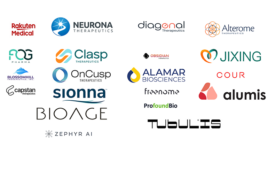
Raymond Deshaies image courtesy of Amgen
A growing number of researchers believe the pharma industry has entered a new wave of innovation involving multispecific medicines. Among them is Ray Deshaies, a biochemist and cell biologist, who is the SVP of global research at Amgen.
In 2020, Deshaies wrote an article for Nature explaining why multispecific drugs may grant access to portions of the proteome currently off-limits for drug targeting. In other words, multispecifics could take aim at previously undruggable disease targets.
Deshaies hosts the new ‘Undruggable’ podcast from Amgen’s R&D team that provides a historical context of drug innovation and insights into multispecific drug discovery and development.
The podcast considers the conclusion that approximately 85% of the human proteome remains “undruggable,” meaning that small molecule drugs are unable to target given proteins to produce desirable effects.
The situation illustrates why it has been so important for pharma companies to move beyond conventional small-molecule drug therapies, and why multispecifics are poised to drive the core of the next wave drug innovation, which is a topic for a forthcoming article.
“There are a variety of reasons why a lot of proteins are just not druggable,” Deshaies said. For example, if proteins are not enzymes, they can be difficult for small molecules to target. Other challenges include proteins lacking pockets. Multifunctional proteins pose another challenge, as do proteins whose main function is to interact with other proteins or nucleic acids like DNA or RNA.
“If targets are extracellular, they tend to be easier to drug because you can make an antibody or a small molecule to them,” Deshaies explains.
If the target is within a cell, small molecule drugs are often a necessity.
A massive size differential
But there are still several potential challenges at play for intracellular targets. “Number one, you just have the massive size differential between a small molecule and a protein,” Deshaies said.
A small molecule drug might have a molecular weight of 0.5 Kilodalton. A typical protein might weigh in the ballpark of 50 Kilodalton, which is 10 times bigger.
It is thus no easy feat for a small molecule drug to incapacitate a protein.
The importance of shape
In addition to the vast size differential, it isn’t easy to target proteins with a smooth surface. “You couldn’t stick a small molecule on something shaped like an egg because there’s nowhere for it to grab onto,” Deshaies said.
But proteins often have complex surfaces and shapes, and when there is a pocket on the protein, that provides a possibility for a drug to fit into and block a chemical conversion. The strategy “works for proteins that are enzymes that carry out chemical conversions, but it doesn’t work for a large majority of proteins,” Deshaies said.
Some proteins have a scaffolding function in which a protein serves as a linker to unite two other proteins. Usually, protein-protein interfaces are large. For example, they could be in the range of 1,000–2,000 Ų. Because such proteins tend to lack pockets, they can be challenging to target.
Transcription factors are another example of a typical protein type. “These are proteins that bind to DNA in a sequence-specific way and activate the expression of genes,” Deshaies said.
Transcription factors lack pockets in which small molecules could fit. And because the surface area of such proteins is so large, they can be difficult for small molecule drugs to target.
Other challenges
Even some extracellular proteins may not be druggable by conventional means.
The PCSK9 enzyme, for instance, which is involved in cholesterol regulation, was initially difficult to target. As a result, several drug companies attempted to use small molecule drugs targeting PCSK9 and failed. “It’s a protease. The way it regulates cholesterol has nothing to do with its protease activity, which is just a quirk of biology.”
There are currently two FDA-approved PCSK9 inhibitors on the market. Both are monoclonal antibodies. They include Amgen’s Repatha (evolocumab) and Praluent (alirocumab) from Regeneron and Sanofi.
Another reason a protein could be difficult to target is if it is multifunctional. “There are a lot of gene fusions that occurred during evolution,” Deshaies said.
If a pharma company makes a small molecule drug that inhibits one protein activity, the other will continue. “And inhibiting one activity without inhibiting the other can even make things worse in some cases,” Deshaies said. “Even if you could drug part of the protein, you couldn’t drug the entire protein because you know it’s literally a fusion of two different protein domains that are carrying out two different chemical transformations,” he added.
Deshaies pointed out that a new drug type known as proteolysis-targeting chimeras (PROTACs) could prove helpful in such circumstances.
A PROTAC can cause targeted protein degradation by bringing a target protein into proximity with enzymes known as ubiquitin ligases. Once that happens, the enzyme attaches the small protein ubiquitin to the target protein, resulting in the degradation of the target. “With a PROTAC, you could bind in one spot on the protein and wipe out the activities at the same time,” Deshaies said.
Filed Under: Drug Discovery and Development





Tell Us What You Think!
You must be logged in to post a comment.